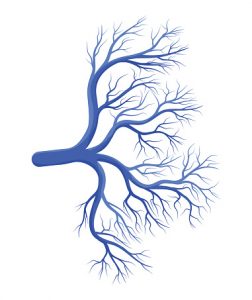
What are blue veins?
Advertisement
Blue veins are venous blood vessels that appear bluish or greenish in color when stretched out beneath the skin. The may also go by the names of reticular veins, feeder veins, or intradermal varices. Blue veins are generally bigger than spider veins seen elsewhere on the body; however, they are not as big as varicose veins typically found in the lower extremities.
Blue veins range in size from 1 to 3 mm in diameter and are generally flatter and less tortuous than varicose veins. They are often seen on the knees and thighs, but you can see blue veins in chests as well.
What do blue veins on the chest mean?
Visible blue veins on chests can afflict both men and women. While blue veins are not a serious problem most of the time, there are some cases that may point to a more serious underlying condition. However, more often than not, they are simply a cosmetic issue.
Prominent blue veins on the chest can cause psychological distress because of their unsightly appearance. Blue veins on chest causes include normal aging, genetics, hormonal changes, or even rapid weight loss.
It is possible for blue veins on the chest to eventually fade away, but this may take a long time. If living with blue veins is a cause of considerable distress, there are several cosmetic treatment options available to eliminate them.
Why are there blue veins on my chest?
Some of the most common causes of blue veins on the chest include:
Genetics: This is the most common cause. If your family members have blue veins on the chest or anywhere else on the body, you will most likely develop them as well.
Rapid weight loss: When the skin becomes thin and fragile due to decreased fat composition, blue veins can emerge. This can occur on the chest as well as the hands, face, and legs.
Regular exercise: Heavy weightlifting and other types of rigorous exercise result in increased blood flow, which is likely to cause the veins in the body to bulge.
Medical conditions: Those suffering from liver conditions such as cirrhosis can be especially susceptible to the development of blue veins on the chest. Other conditions that involve the accumulation of fluid in the abdomen or an enlarged abdomen can lead to blue vein development.
Hormones: Blue veins on the breasts can be related to the phases of a woman’s menstrual cycle. During these times, blue veins may become more visible as the breasts respond to changes in hormone levels. Most of the time in these cases, blue veins fade away naturally with the end of the menstrual cycle, but sometimes they can linger. Hormonal changes during puberty and pregnancy can also cause blue vein development.
How to cure blue veins on the chest?
The first thing to consider when looking at treatment options for your blue veins is whether the veins are a temporary result of hormonal changes. It is also important to determine if they may be caused by an underlying condition such as liver disease, which will need to be treated first.
If your blue veins are simply a cosmetic issue, there are a couple of treatment options you can choose from to get rid of them.
Laser therapy: This includes YAG laser and pulsed dye laser treatments. Both forms of laser therapy are great choices for getting rid of visible blue veins on the chest and other areas of the body. The pulsed dye laser targets the visible veins with a concentrated beam of light and they fade away permanently. The YAG laser works in much the same fashion, but it is better suited to dealing with deeper blue veins.
Sclerotherapy: This treatment involves the injection of a sclerosing agent directly into the veins so that they collapse permanently. Sclerotherapy can be done in the doctor’s office and works very well on blue veins on the chest.
Vitamin K cream: Vitamin K helps to strengthen the skin and increase the elasticity of blood vessels when applied topically.
Advertisement
Concealers: Covering up blue veins with makeup may be a viable option if you don’t want to seek medical treatment or use invasive procedures.
Blue veins on the chest may not look very appealing, but unless they’re caused by an underlying medical condition, they generally aren’t a cause for concern. It is recommended that you speak to a medical professional about your blue veins to get a better idea of what your best treatment options are.
Sources:
http://www.stjohnsvein.com/conditions/blue-veins/
https://www.epainassist.com/vascular-disease/blue-veins-on-chest
http://www.tandurust.com/health-qna/blue-veins-chest-breasts-causes.html
